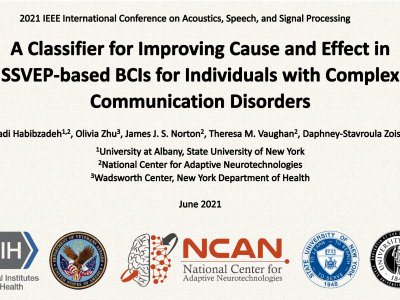Documents
Presentation Slides
A classifier for improving cause and effect in SSVEP-based BCIs for individuals with complex communication disorders

- Citation Author(s):
- Submitted by:
- Mohamadhadi Hab...
- Last updated:
- 24 June 2021 - 1:54pm
- Document Type:
- Presentation Slides
- Document Year:
- 2021
- Event:
- Presenters:
- Hadi Habibzadeh
- Paper Code:
- ICASSP-4461
- Categories:
- Log in to post comments
We present CCACUSUM, a classifier for steady-state visual evoked potential (SSVEP)-based brain-computer interfaces (BCIs) that determines whether a user is attending to a flickering stimulus or is at rest. Correct classification of these two states establishes cause and effect between the BCI and its user, which is essential for helping individuals with complex communication disorders (CCDs) communicate. However, the low signal-to-noise ratio SSVEPs of individuals with CCDs often leads to the incorrect detection of transitions between states, undermining the relationship between cause and effect. To address this challenge, CCACUSUM detects transitions between states and then infers the user’s state from these transitions. To test our algorithm, we compared CCACUSUM to a traditional canonical correlation analysis classifier using electroencephalography (EEG) data collected from four participants using MusicBox—a simple SSVEP-based BCI. Compared with the traditional classifier, CCACUSUM correctly identified true transitions in user state while reducing the number of falsely detected transitions. This improves the cause and effect relationship between the BCI and the user and, with further development, should improve the ability of people with CCDs to use SSVEP-based BCIs to communicate.

